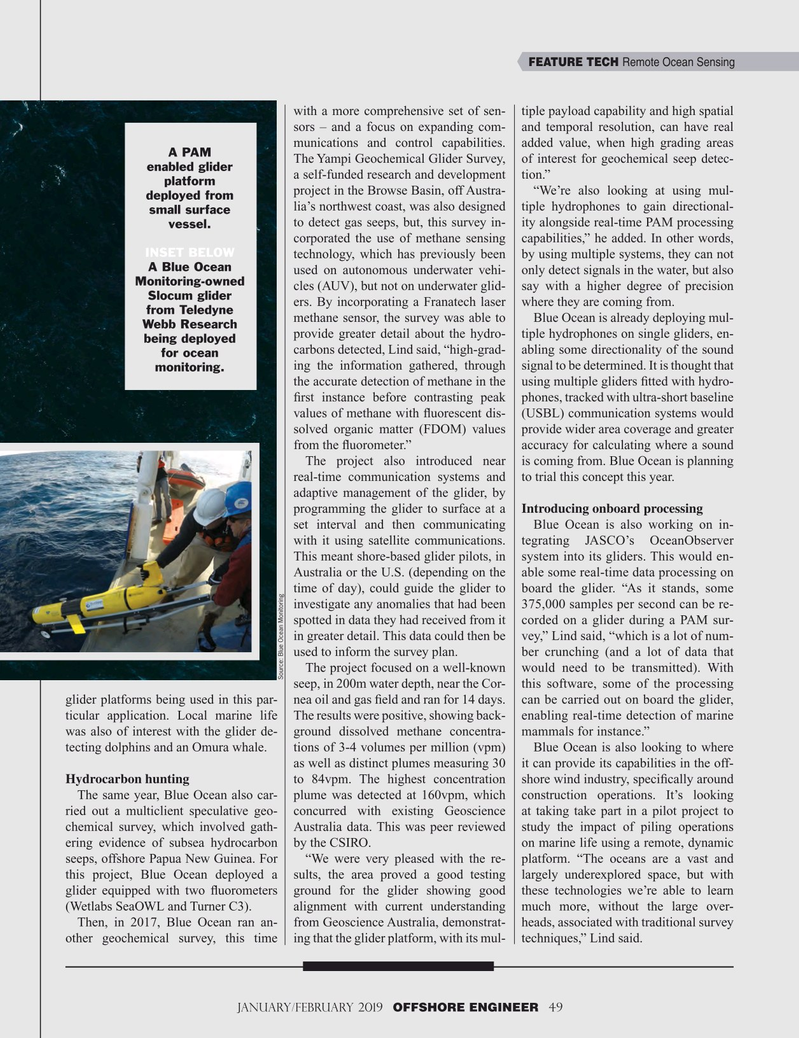
Page 49: of Offshore Engineer Magazine (Jan/Feb 2019)
FPSO/FNLG Outlook and Technologies
Read this page in Pdf, Flash or Html5 edition of Jan/Feb 2019 Offshore Engineer Magazine
FEATURE TECH Remote Ocean Sensing with a more comprehensive set of sen- tiple payload capability and high spatial sors – and a focus on expanding com- and temporal resolution, can have real munications and control capabilities. added value, when high grading areas
A PAM
The Yampi Geochemical Glider Survey, of interest for geochemical seep detec- enabled glider a self-funded research and development tion.” platform project in the Browse Basin, off Austra- “We’re also looking at using mul- deployed from lia’s northwest coast, was also designed tiple hydrophones to gain directional- small surface to detect gas seeps, but, this survey in- ity alongside real-time PAM processing vessel.
corporated the use of methane sensing capabilities,” he added. In other words,
INSET BELOW technology, which has previously been by using multiple systems, they can not
A Blue Ocean used on autonomous underwater vehi- only detect signals in the water, but also
Monitoring-owned cles (AUV), but not on underwater glid- say with a higher degree of precision
Slocum glider ers. By incorporating a Franatech laser where they are coming from.
from Teledyne methane sensor, the survey was able to Blue Ocean is already deploying mul-
Webb Research provide greater detail about the hydro- tiple hydrophones on single gliders, en- being deployed carbons detected, Lind said, “high-grad- abling some directionality of the sound for ocean ing the information gathered, through signal to be determined. It is thought that monitoring.
the accurate detection of methane in the using multiple gliders ? tted with hydro- ? rst instance before contrasting peak phones, tracked with ultra-short baseline values of methane with ? uorescent dis- (USBL) communication systems would solved organic matter (FDOM) values provide wider area coverage and greater from the ? uorometer.” accuracy for calculating where a sound
The project also introduced near is coming from. Blue Ocean is planning real-time communication systems and to trial this concept this year. adaptive management of the glider, by programming the glider to surface at a Introducing onboard processing set interval and then communicating Blue Ocean is also working on in- with it using satellite communications. tegrating JASCO’s OceanObserver
This meant shore-based glider pilots, in system into its gliders. This would en-
Australia or the U.S. (depending on the able some real-time data processing on time of day), could guide the glider to board the glider. “As it stands, some investigate any anomalies that had been 375,000 samples per second can be re- spotted in data they had received from it corded on a glider during a PAM sur- in greater detail. This data could then be vey,” Lind said, “which is a lot of num- used to inform the survey plan. ber crunching (and a lot of data that
The project focused on a well-known would need to be transmitted). With
Source: Blue Ocean Monitoring seep, in 200m water depth, near the Cor- this software, some of the processing glider platforms being used in this par- nea oil and gas ? eld and ran for 14 days. can be carried out on board the glider, ticular application. Local marine life The results were positive, showing back- enabling real-time detection of marine was also of interest with the glider de- ground dissolved methane concentra- mammals for instance.” tecting dolphins and an Omura whale. tions of 3-4 volumes per million (vpm) Blue Ocean is also looking to where as well as distinct plumes measuring 30 it can provide its capabilities in the off-
Hydrocarbon hunting to 84vpm. The highest concentration shore wind industry, speci? cally around
The same year, Blue Ocean also car- plume was detected at 160vpm, which construction operations. It’s looking ried out a multiclient speculative geo- concurred with existing Geoscience at taking take part in a pilot project to chemical survey, which involved gath- Australia data. This was peer reviewed study the impact of piling operations ering evidence of subsea hydrocarbon by the CSIRO. on marine life using a remote, dynamic seeps, offshore Papua New Guinea. For “We were very pleased with the re- platform. “The oceans are a vast and this project, Blue Ocean deployed a sults, the area proved a good testing largely underexplored space, but with glider equipped with two ? uorometers ground for the glider showing good these technologies we’re able to learn (Wetlabs SeaOWL and Turner C3). alignment with current understanding much more, without the large over-
Then, in 2017, Blue Ocean ran an- from Geoscience Australia, demonstrat- heads, associated with traditional survey other geochemical survey, this time ing that the glider platform, with its mul- techniques,” Lind said.
January/February 2019 OFFSHORE ENGINEER 49 32-49 OE 2019.indd 49 32-49 OE 2019.indd 49 1/22/2019 11:39:21 AM1/22/2019 11:39:21 AM

 48
48

 50
50